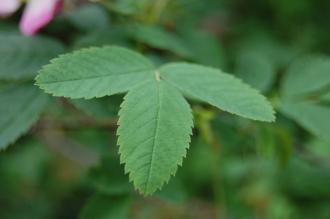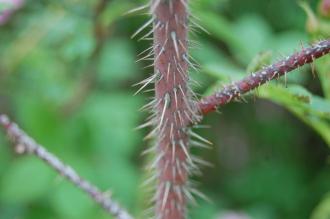
Rosa sericea (22/05/2016, Kew Gardens, London)
Position: Full sun to light shade
Flowering period: Early summer
Soil: Moist, well drained
Eventual Height: 2m
Eventual Spread: 2m
Hardiness: 5a, 5b, 6a, 6b, 7a, 7b, 8a, 8b, 9a, 9b
Family: Rosaceae

Rosa sericea Flower (22/05/2016, Kew Gardens, London)
Rosa sericea is a deciduous shrub with an upright arching habit. Its mid green leaves are are odd pinnate, up to 8cm long with up to 11 leaflets. Its leaflets are ovate with serrate margins, up to 2cm long and 8mm across. Its stems or canes are very thorny. Its pink flowers are single, contain four petals, are up to 5cm across, have a white center with yellow stamen. Its red fruit is a hip which are up to 15mm across.
Rosa sericea, commonly known as Silky Rose, is native to southwest China, north India and Burma. In its native habitat it grows in mountainous regions at an altitude of between 2,000m and 4,000m at forest margins and open woodlands.

Rosa sericea Leaf (22/05/2016, Kew Gardens, London)
The etymological root of the binomial name Rosa is from the ancient Latin name for the rose. Sericea is derived from the Latin serica meaning ‘silken’.
The landscape architect may find Rosa sericea useful as an effective informal barrier hedge.
Ecologically, Rosa sericea flowers are attractive to pollinating insects. Its hips are attractive to birds during the winter months.

Rosa sericea Stem (22/05/2016, Kew Gardens, London)
Rosa sericea prefers moist, humus rich, well-drained soils. It tolerates most pH of soil. It dislikes wet soils.
Rosa sericea requires little maintenance. Pruning should be carried out once flowering is complete. Obviously if pruning is carried out after flowering no hips will follow.

Landscape Architecture

